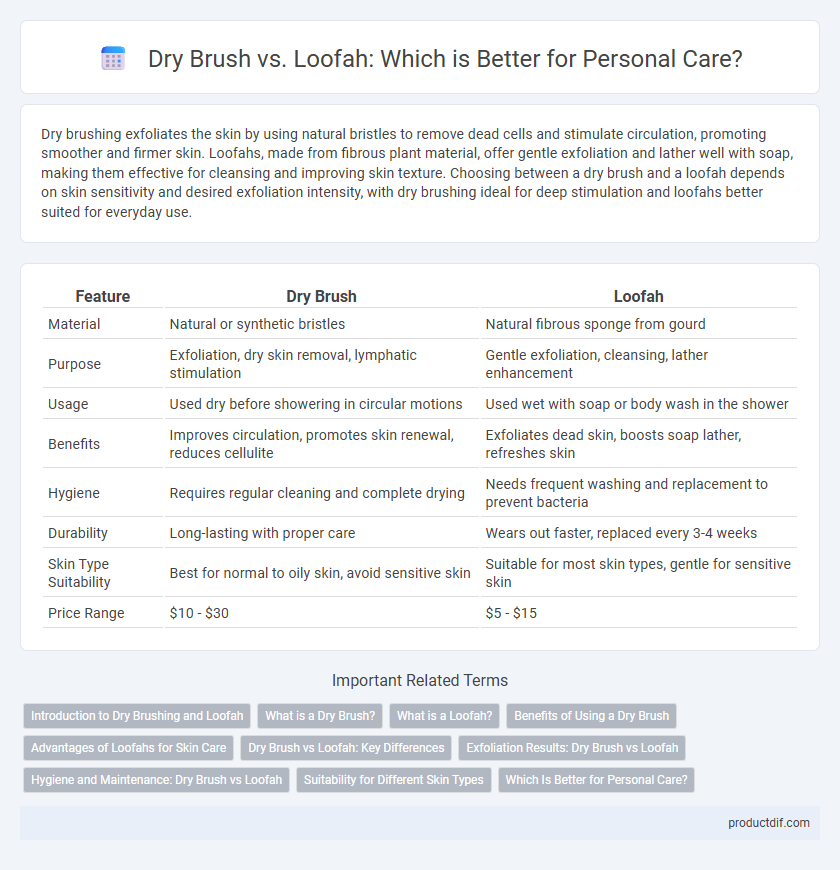Dry brushing exfoliates the skin by using natural bristles to remove dead cells and stimulate circulation, promoting smoother and firmer skin. Loofahs, made from fibrous plant material, offer gentle exfoliation and lather well with soap, making them effective for cleansing and improving skin texture. Choosing between a dry brush and a loofah depends on skin sensitivity and desired exfoliation intensity, with dry brushing ideal for deep stimulation and loofahs better suited for everyday use.
Table of Comparison
| Feature | Dry Brush | Loofah |
|---|---|---|
| Material | Natural or synthetic bristles | Natural fibrous sponge from gourd |
| Purpose | Exfoliation, dry skin removal, lymphatic stimulation | Gentle exfoliation, cleansing, lather enhancement |
| Usage | Used dry before showering in circular motions | Used wet with soap or body wash in the shower |
| Benefits | Improves circulation, promotes skin renewal, reduces cellulite | Exfoliates dead skin, boosts soap lather, refreshes skin |
| Hygiene | Requires regular cleaning and complete drying | Needs frequent washing and replacement to prevent bacteria |
| Durability | Long-lasting with proper care | Wears out faster, replaced every 3-4 weeks |
| Skin Type Suitability | Best for normal to oily skin, avoid sensitive skin | Suitable for most skin types, gentle for sensitive skin |
| Price Range | $10 - $30 | $5 - $15 |
Introduction to Dry Brushing and Loofah
Dry brushing involves using a natural bristle brush to exfoliate skin, promoting circulation and lymphatic drainage. Loofahs, made from fibrous plant material, offer a textured surface that gently removes dead skin cells and improves skin texture. Both tools support skin renewal but differ in material and exfoliation technique, catering to varied skincare preferences.
What is a Dry Brush?
A dry brush is a natural bristle brush used for exfoliating the skin without water, promoting circulation and lymphatic drainage. It effectively removes dead skin cells and can help improve skin texture and tone. Unlike a loofah, which is typically used wet for cleansing, dry brushing is performed on dry skin before showering.
What is a Loofah?
A loofah is a natural exfoliating sponge derived from the fibrous skeleton of the Luffa plant, commonly used in personal care routines to remove dead skin cells and improve circulation. Unlike synthetic brushes, loofahs are biodegradable and provide gentle yet effective exfoliation, promoting smoother, healthier skin. Regular use of a loofah helps prevent clogged pores and enhances the absorption of moisturizers and body oils.
Benefits of Using a Dry Brush
Dry brushing stimulates lymphatic drainage, promoting detoxification and improving circulation for healthier, glowing skin. It exfoliates dead skin cells more effectively than a loofah, revealing smoother texture and reducing the appearance of cellulite. Regular use of a dry brush helps unclog pores and supports natural skin renewal without the harsh scrubbing associated with loofahs.
Advantages of Loofahs for Skin Care
Loofahs offer superior exfoliation by gently removing dead skin cells, which promotes smoother and healthier skin texture. Their natural, fibrous structure enhances blood circulation and stimulates lymphatic drainage, aiding in toxin elimination. Unlike synthetic alternatives, loofahs are biodegradable and more environmentally friendly, making them a sustainable choice for eco-conscious skin care routines.
Dry Brush vs Loofah: Key Differences
Dry brush uses natural, stiff bristles to exfoliate skin, improve circulation, and promote lymphatic drainage, while loofah is a fibrous sponge derived from gourds that provides gentle exfoliation and cleansing. Dry brushing typically targets dry skin and enhances skin texture through rigorous, targeted strokes, whereas loofahs offer a softer, more hydrating scrub suitable for wet skin and daily use. The durability and maintenance differ as dry brushes require regular cleaning to prevent bacterial buildup, while loofahs need frequent replacement to avoid mold and mildew growth.
Exfoliation Results: Dry Brush vs Loofah
Dry brushes provide deep exfoliation by removing dead skin cells through firm, repetitive strokes that stimulate circulation and promote smoother skin. Loofahs offer gentler exfoliation with a natural texture that effectively cleanses and exfoliates without causing irritation, ideal for sensitive skin. Choosing between dry brushes and loofahs depends on skin type and desired exfoliation intensity, with dry brushes delivering more robust results and loofahs offering a softer, more hygienic experience.
Hygiene and Maintenance: Dry Brush vs Loofah
Dry brushes offer superior hygiene compared to loofahs due to their quick-drying natural bristles that inhibit bacterial growth, whereas loofahs retain moisture longer, making them prone to mold and mildew. Regular cleaning and thorough drying are essential for both, but dry brushes require less frequent replacement, improving long-term maintenance. Choosing a dry brush reduces the risk of skin infections and supports a cleaner, more sustainable personal care routine.
Suitability for Different Skin Types
Dry brushes are ideal for individuals with normal to oily skin, providing gentle exfoliation while stimulating circulation without causing irritation. Loofahs suit those with tougher, more resilient skin types, effectively removing dead skin cells and promoting smoother skin but may be too abrasive for sensitive or dry skin. For sensitive or dry skin, soft washcloths or silicone scrubbers are recommended to avoid irritation and maintain skin hydration.
Which Is Better for Personal Care?
Dry brushes offer superior exfoliation by stimulating blood circulation and promoting lymphatic drainage, ideal for improving skin texture and reducing cellulite. Loofahs provide gentle cleansing and exfoliation, making them suitable for daily use on sensitive skin without causing irritation. Choosing between dry brush and loofah depends on individual skin type and desired benefits, with dry brushes favored for deep exfoliation and loofahs preferred for mild cleansing.
Dry Brush vs Loofah Infographic

 productdif.com
productdif.com